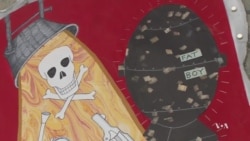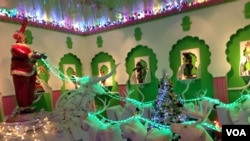In a room glowing brightly from hundreds of twinkling LED light bulbs, the sound of Christmas carols - sung in Hindi and Punjabi - fill the air, as a misshapen Santa Claus stands atop a flying saucer and a huge spaceship with a carousel on top hovers nearby.
This unusual holiday scene by artist Kenny Irwin Jr. -- a practicing Muslim -- is a bold statement about the commercialization of Christmas in which traditional holiday objects like reindeer and nutcrackers have been transformed from the familiar to the bizarre.
The unusual display is part of a new exhibit called "Human, Soul & Machine: The Coming Singularity!" at the American Visionary Art Museum in Baltimore, Maryland, which examines the impact of technology on human life as told through the eyes of more than 40 artists, futurists and inventors.
Museum founder and director Rebecca Hoffberger is also the curator of the exhibit. Every year she picks a serious theme for a major exhibit to get people thinking. This year, it's about the blessing and the dangers of technology.
"Because,” she said, “technology is becoming increasingly powerful globally at rates never before witnessed.”
Technology's impact
The exhibit begins with an exploration of what Hoffberger believes is the birth of technology: the discovery of fire.
“Fire begins our capacity to manipulate our environment -- the earth -- that was a gift to all of us,” she said.
That gift was a two-edged sword, she added. While it offered wonderful benefits, like heat and light, "what fire unleashed is really the whole chemical world; the ability to smelt metals and make swords, guns, tanks, and in the blink of an eye, the atomic bomb.”
Warfare
In light of that consideration, a whole section of the exhibit is devoted to warfare, from a single, powerful image of the atomic bomb, to a series of drawings by artist Rigo 23 that explore the ethics of drone usage.
There’s even a two-meter-tall "Godzilla," inspired by the original mythical figure that was first created in response to the devastating effects of the atom bombs dropped on Hiroshima and Nagasaki.
Numerous images and signs in strategic areas of the museum remind visitors of the cost of war.
Mother earth
Other images in the exhibition explore the destruction of the environment, as captured in a painting called "Gaia" by artist Alex Grey.
"On one-half of the tree of life is earth, idyllic in harmony with human kind; we’re vegetarians, we’re not in any way harming nature. But on the other, it’s what we’ve done to manipulate nature,” Hoffberger said.
And the presence of a life-size gorilla covered with aluminum sends a powerful message about the threatened existence of this great ape species and the plundering of ancient forests for the popular metal.
“Aluminum, because it was so difficult to refine for a period of humanity’s time, was much more valuable than gold,” said Hoffberger. “But at the same time, the moment they found a way to refine it, aluminum became the stuff we wrap around a hot dog and throw away in the trash.”
Human Soul
Another work of art by Alex Grey is his “Sacred Mirrors” series of paintings, which artfully explores the connection between body and soul.
Adam Kurtzman’s full-size “The Bride of Frankenstein” represents mankind’s historic fascination with control over life and death.
Sculptor Allen Christian, who has two works in the exhibit, is nostalgic for the days when handmade tools and objects were valued. His robot, “Ajax,” is made from items like railroad spikes that once held importance but have since been discarded.
“These things are imbued with energy from the people that made them, designed them, used them,” he said. “It’s about trying to put them back together to give it a different life.”
His “Piano Family” -- made out of spare piano parts -- represents a bygone era when things now made by machine were crafted by hand.
“Having a piano where the family would be around it,” he said, “was about being together and this was a forum where we bonded,” he said. “There was something very powerful about music that I think was lost when recordings came out when you didn’t have to participate.”
Good technology
There are displays in the exhibition representing the positive side of technology; a video of one of Henry Ford’s cars for example, and a wooden replica of the Wright brothers’ airplane. But the loss of our humanity permeates the show.
One of the most powerful is Fred Carter's series of giant wooden carvings. One of them, titled “The Final Battle,” depicts on one side the face of an anguished human and on the other, his transformation into a robot.
The piece is made out of a single piece of wood, and warns of the consequences of the industrial manipulation of nature.
“Fred was so worried that humanity was going to lose its humanity,” said Hoffberger. “And he shows here on the robot side, the bits of copper wire coming out of us that we’re no longer quite human.”
Purpose
“With every exhibition, I try to prepare something absolutely delicious for a three-year-old to eat in terms of eye candy and flashing lights,” said Hoffberger, but she also wanted something “that a Nobel Prize winner can love and learn from.”
On this day a group of visiting students from a nearby school seemed transfixed by the blend of art, science, humor and imagination.
Victoria Greenia, 12, said she felt the exhibition “shows how technology has helped us and yet has destroyed our environment in a way.”
Angus Gatlin, 11, was mesmerized by Grey’s "Gaia."
“I liked this one in specific because I thought it was really powerful…if you notice all the animals are dying…I think the whole message is, ‘Watch what you’re doing,’” he said.
While many of the displays in the exhibition are playful, the serious question at the heart of it all, is will we use our ever-evolving technology for positive or negative purposes?
This unusual holiday scene by artist Kenny Irwin Jr. -- a practicing Muslim -- is a bold statement about the commercialization of Christmas in which traditional holiday objects like reindeer and nutcrackers have been transformed from the familiar to the bizarre.
The unusual display is part of a new exhibit called "Human, Soul & Machine: The Coming Singularity!" at the American Visionary Art Museum in Baltimore, Maryland, which examines the impact of technology on human life as told through the eyes of more than 40 artists, futurists and inventors.
Museum founder and director Rebecca Hoffberger is also the curator of the exhibit. Every year she picks a serious theme for a major exhibit to get people thinking. This year, it's about the blessing and the dangers of technology.
"Because,” she said, “technology is becoming increasingly powerful globally at rates never before witnessed.”
Technology's impact
The exhibit begins with an exploration of what Hoffberger believes is the birth of technology: the discovery of fire.
“Fire begins our capacity to manipulate our environment -- the earth -- that was a gift to all of us,” she said.
That gift was a two-edged sword, she added. While it offered wonderful benefits, like heat and light, "what fire unleashed is really the whole chemical world; the ability to smelt metals and make swords, guns, tanks, and in the blink of an eye, the atomic bomb.”
Warfare
In light of that consideration, a whole section of the exhibit is devoted to warfare, from a single, powerful image of the atomic bomb, to a series of drawings by artist Rigo 23 that explore the ethics of drone usage.
There’s even a two-meter-tall "Godzilla," inspired by the original mythical figure that was first created in response to the devastating effects of the atom bombs dropped on Hiroshima and Nagasaki.
Numerous images and signs in strategic areas of the museum remind visitors of the cost of war.
Mother earth
Other images in the exhibition explore the destruction of the environment, as captured in a painting called "Gaia" by artist Alex Grey.
"On one-half of the tree of life is earth, idyllic in harmony with human kind; we’re vegetarians, we’re not in any way harming nature. But on the other, it’s what we’ve done to manipulate nature,” Hoffberger said.
And the presence of a life-size gorilla covered with aluminum sends a powerful message about the threatened existence of this great ape species and the plundering of ancient forests for the popular metal.
“Aluminum, because it was so difficult to refine for a period of humanity’s time, was much more valuable than gold,” said Hoffberger. “But at the same time, the moment they found a way to refine it, aluminum became the stuff we wrap around a hot dog and throw away in the trash.”
Human Soul
Another work of art by Alex Grey is his “Sacred Mirrors” series of paintings, which artfully explores the connection between body and soul.
Adam Kurtzman’s full-size “The Bride of Frankenstein” represents mankind’s historic fascination with control over life and death.
Sculptor Allen Christian, who has two works in the exhibit, is nostalgic for the days when handmade tools and objects were valued. His robot, “Ajax,” is made from items like railroad spikes that once held importance but have since been discarded.
“These things are imbued with energy from the people that made them, designed them, used them,” he said. “It’s about trying to put them back together to give it a different life.”
His “Piano Family” -- made out of spare piano parts -- represents a bygone era when things now made by machine were crafted by hand.
“Having a piano where the family would be around it,” he said, “was about being together and this was a forum where we bonded,” he said. “There was something very powerful about music that I think was lost when recordings came out when you didn’t have to participate.”
Good technology
There are displays in the exhibition representing the positive side of technology; a video of one of Henry Ford’s cars for example, and a wooden replica of the Wright brothers’ airplane. But the loss of our humanity permeates the show.
One of the most powerful is Fred Carter's series of giant wooden carvings. One of them, titled “The Final Battle,” depicts on one side the face of an anguished human and on the other, his transformation into a robot.
The piece is made out of a single piece of wood, and warns of the consequences of the industrial manipulation of nature.
“Fred was so worried that humanity was going to lose its humanity,” said Hoffberger. “And he shows here on the robot side, the bits of copper wire coming out of us that we’re no longer quite human.”
Purpose
“With every exhibition, I try to prepare something absolutely delicious for a three-year-old to eat in terms of eye candy and flashing lights,” said Hoffberger, but she also wanted something “that a Nobel Prize winner can love and learn from.”
On this day a group of visiting students from a nearby school seemed transfixed by the blend of art, science, humor and imagination.
Victoria Greenia, 12, said she felt the exhibition “shows how technology has helped us and yet has destroyed our environment in a way.”
Angus Gatlin, 11, was mesmerized by Grey’s "Gaia."
“I liked this one in specific because I thought it was really powerful…if you notice all the animals are dying…I think the whole message is, ‘Watch what you’re doing,’” he said.
While many of the displays in the exhibition are playful, the serious question at the heart of it all, is will we use our ever-evolving technology for positive or negative purposes?










